By SCOTT MCKIE B.P.
ONE FEATHER STAFF
As families navigate the new landscape of home schooling their children, many Cherokee families are incorporating aspects of the culture into their curriculum.
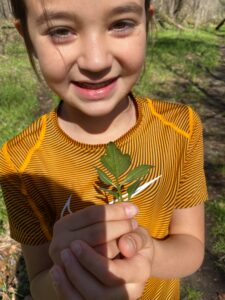
Cambry Stamper shows off some sochan she picked this past week. The family has been incorporating Cherokee food knowledge and gathering into their homeschool lessons. (Photo courtesy of Stamper family)
The Stamper family has been busy gathering wild foods such as ramps, sochan, mushrooms, and fishing; working on Cherokee language using vocabulary and narratives in conversation; and art creating Cherokee clothing and jewelry.
“I believe it is very important for our girls to understand the importance of who they are, Cherokee,” said Miranda Stamper, a member of the Eastern Band of Cherokee Indians (EBCI). “With that comes gathering of wild foods, fishing, and gardening – understanding why they used what they used for footwear, jewelry, and cookware. Before, we had to find time for these things between sports, school, and other athletic events. We hardly had time. Now, we do these things daily.”
She added, “Both of my girls have made their own Stomp skirts and are working on their own pucker-toe moccasins. They are also making corn bead necklaces.”
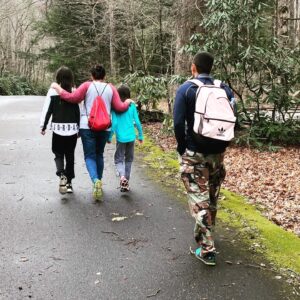
The Stamper family takes a hike in the woods en route to dig wild ramps. Shown, left to right, are – Joscelyn; mother, Miranda; Cambry; and father, Rob. (Photo courtesy of the Stamper family)
Her daughter, Joscelyn Stamper, 11, is a fifth grader at Cherokee Elementary School. “I like ramp digging because we get to be outside with my whole family and my grannies come and dig with us too.”
Miranda’s younger daughter, Cambry Stamper, 9, a third grader at Cherokee Elementary, said, “I like gathering greens and ramp digging because I hunt for them, find them, cut them, carry them out, clean them, and watch mom cook them for everyone to eat.”
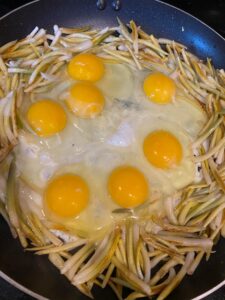
The Stamper family cooks up a nice dish of ramps and eggs from wild ramps they gathered as a family. (Photo courtesy of the Stamper family)
Caleb Hickman, a Cherokee Nation citizen originally from Oklahoma, who is the supervisory fish and wildlife biologist for EBCI Natural Resources, said, “”When the weather is nice, we spend much more time outside. I’ve tried to show them about plants and animals, and I always try to add some cultural context. My kids go to water when first approaching a branch – so, we get to that more often – which I strongly believe helps them.”
Caleb also is trying to work Cherokee language into the mix as much as possible. “I’ve been trying to learn the language more myself as it is a State of Emergency for all Cherokee tribes, so trying to teach is a great way to learn. My older son has taken to white board sessions for Syllabary. He’s already learned a lot and can see how the language could be fun. He is hungry to learn more and incredibly talented.”
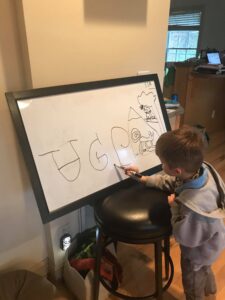
Milo Hickman, 6, a Cherokee Nation citizen residing in Jackson County, writes in the Cherokee Syllabary on a white board at his home. (Photo courtesy of the Hickman family)
Caleb and his sons, Milo, 6, in Kindergarten at Fairview Elementary School, and Waylon, 2, in pre-school at Cullowhee Kids – are all Cherokee Nation citizens. “Since we’re descendants of those that walked the Trail of Tears and we live in Jackson County, it’s very important to me that they know their heritage. It’s a rare opportunity to raise your own kids – most people these days don’t get to do it. I spend nine hours a day without them. They learn Spanish and a way of thinking that isn’t mine. Now, I have a valuable opportunity to pass on more than just my genes.”
Milo commented, “I like learning new Cherokee words.”
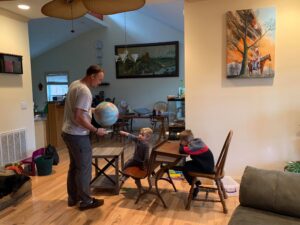
Caleb Hickman, a Cherokee Nation citizen and supervisory fish and wildlife biologist for EBCI Natural Resources, teaches his sons, Waylon and Milo, about the globe. They have been incorporating Cherokee traditions and language into many aspects of their home schooling experience. (Photo courtesy of the Hickman family)
Caleb has the following advice for other parents wishing to incorporate more cultural traditions, life ways, and ideals into their curriculum. “Call people and use tribal pages for resources. Also, you might not even know that you have cultural knowledge yourself. I didn’t know it until I left home and realized people didn’t do things the same everywhere. Just show the kids things you learned. I find most of it is tied to food and outdoor time. So, turn off the TV and other electronics. Don’t let devices raise your kids.”
Miranda has similar advice, “Get outside! Besides the obvious, it’s great exercise! There is no replacement for quality, uninterrupted family time. Being Cherokee, this is something I would love to instill in my girls – a strong, bonded family that can overcome anything.”




